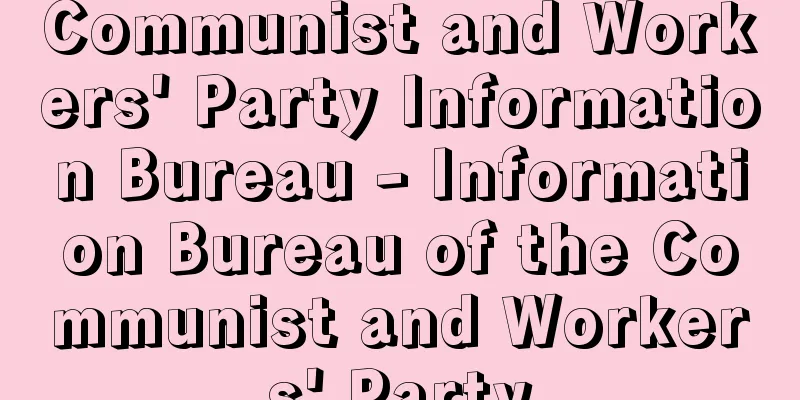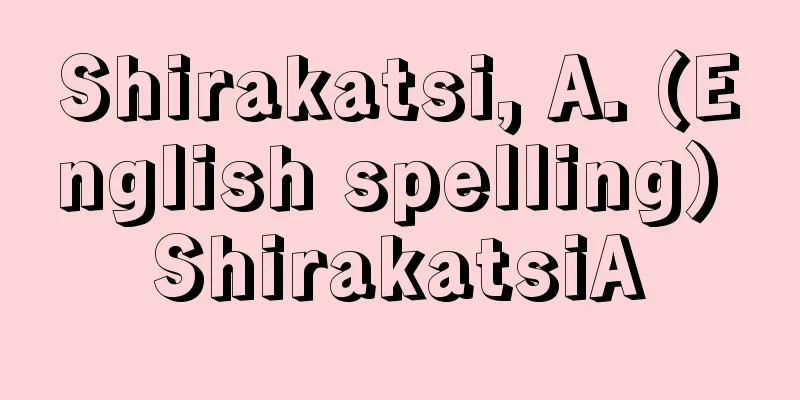Kamo no Chomei - Kamo no Chomei

|
A poet, essayist, and story collection editor from the end of the Heian period to the early Kamakura period. He was the son of Kamo Nagatsugu, a priest at Kamo no Mioya (Shimogamo) Shrine in Kyoto. In his youth, he was called Kikudaibu. The correct reading is Nagaakira, but he is usually pronounced Choumei. After he became a monk, his posthumous name was Ren'in. His father was a capable man who had served as a chief priest at Kawaisha (an affiliated shrine of Shimogamo Shrine) and had served as the highest priest at Shimogamo Shrine, the chief chief priest, at a young age, but he died young when Chomei was around 20 years old. Chomei, who became an "orphan" (Mumyosho, Minamoto Ienaga Nikki), learned waka poetry from Minamoto Toshiyori's son Shun'e and biwa from Nakahara Ariyasu. In his 30s, he had one poem included in the imperial anthology Senzai Wakashu (completed in 1187), becoming the first imperially commissioned poet. From then on, he participated in many poetry contests, including "Shoji Ninen no Nidai Hyakushu" (completed in 1200), and was prominent as a poet. In 1201 (Kennin 1), the Wakadokoro was restored by order of Emperor Gotoba, and Chomei was appointed as a Yoryudo (staff member). He mingled with influential professional poets such as Fujiwara Teika and Fujiwara Ietaka, and worked so diligently that it was said that "he never left his position, and worked day and night without fail" (Minamoto Ienaga Nikki). This was also the most honorable and fulfilling period of his life for Chomei. Emperor Gotoba noticed Chomei's diligent work and tried to recommend him as a priest at Kawai Shrine, which was connected to his father Nagatsugu, but this was opposed by his relative Kamo Sukekane, and Chomei, disappointed, became a monk. According to the description in "Hojoki" (completed in 1212), this is estimated to have been around the age of 50. Afterwards, he retired to Ohara (there are two theories about where he lived, either in Rakuhoku or Seizan), and then, through connections with his friend Zenjaku (Fujiwara Nagachika), he moved to the vicinity of Hino Hokaiji Temple, where he built a hermitage in the Hojo, and is estimated to have died there around June 8th, leap year 4 of Kenpo. During his time living in Hino, he traveled to Kamakura, met with Minamoto no Sanetomo, and wrote "Hojoki." His representative work, "Hōjōki," depicts the impermanence of the world and the peace of the hōjō's hermitage in a graceful mixture of Japanese and Chinese prose, and ranks alongside Kenkō's later work, "Tsurezuregusa" (completed around 1331), as one of the great works of hermit literature. In addition to works such as the waka treatise "Mumyōshō" (perhaps completed after 1211) and the Buddhist tale collection "Hosshinshū" (perhaps completed around 1215), he also wrote a family anthology, "Kamo no Chomeishū" (completed in 1181), one of which was included in the "Senzai Wakashū," and ten in the "Shin Kokin Wakashū" (completed in 1205). [Kazuhiko Asami] "Complete Works of Kamo no Chomei, edited by Yanase Kazuo, 1 volume (1956, Kazama Shobo)" ▽ "Shincho Japanese Classics Collection, Hojoki and Hōsinshū, annotated by Miki Norito (1976, Shinchosha)" [References] | | |Part 1: Written by Kamo no Chomei, published in the National Diet Library "Mumei Sho" Old type edition by Kamo no Chomei, published in 1647 (4th year of the Shoho era), owned by the National Diet Library "Hojoki" Source: Shogakukan Encyclopedia Nipponica About Encyclopedia Nipponica Information | Legend |
|
平安末期から鎌倉初期の歌人、随筆家、説話集編者。京の賀茂御祖(かもみおや)(下鴨(しもがも))神社の神官鴨長継(ながつぐ)の子。少年期には菊大夫(きくだいぶ)といわれる。長明(ながあきら)と読むのが正しいが、普通、音読して長明(ちょうめい)とよぶ。出家後の法名は蓮胤(れんいん)。 父は河合社(かわいしゃ)(下鴨神社の付属社)の禰宜(ねぎ)を経て、若くして下鴨神社の最高の神官、正禰宜惣官(しょうねぎそうかん)を務めたほどの有能な人物であったが、長明20歳前後のころに早世する。「みなしご」(『無名抄(むみょうしょう)』『源家長日記』)となった長明は和歌を源俊頼(としより)の子俊恵(しゅんえ)に、琵琶(びわ)を中原有安に学ぶ。30代に勅撰(ちょくせん)集『千載(せんざい)和歌集』(1187成立)に1首入集(にっしゅう)、初めて勅撰歌人となる。以後『正治(しょうじ)二年院第二度百首』(1200成立)のほか、多くの歌合(うたあわせ)に出席、歌人としての活躍が目だつ。1201年(建仁1)、後鳥羽院(ごとばいん)の命により和歌所が再興され、長明も寄人(よりゅうど)(職員)に任命されるに至る。藤原定家(ていか)や藤原家隆(いえたか)などの有力な専門歌人とも交じり合い、「まかり出づることもなく、夜昼、奉公おこたらず」(『源家長日記』)といわれるほどまで熱心に勤務、長明にとっても生涯のなかでもっとも光栄に満ち、充実した時期でもあった。長明の精勤ぶりを後鳥羽院は目に留め、父長継ゆかりの河合社の神官に推挙しようとするが、同族の鴨祐兼(すけかね)の反対によって実現せず、失意の長明は出家してしまう。『方丈記』(1212成立)の記述によれば50歳ごろのことと推定される。その後、大原(洛北(らくほく)、西山の両説あり)に隠棲(いんせい)、さらに知友の禅寂(ぜんじゃく)(藤原長親(ながちか))らの縁で日野法界寺(ほうかいじ)の近辺に移り、方丈の庵(いおり)を構え、建保(けんぽう)4年閏(うるう)6月8日ごろ、当地で没したと推定される。この日野在住時代には、鎌倉への下向、および源実朝(さねとも)との面談、『方丈記』の執筆などが行われた。 代表作『方丈記』は、世の無常と方丈の庵の平安を流麗な和漢混交文で描いたもので、後の兼好の『徒然草(つれづれぐさ)』(1331ころ成立)と並ぶ、隠者文学の双璧(そうへき)をなす。歌論書『無名抄』(1211以後の成立か)、仏教説話集『発心集(ほっしんしゅう)』(1215ころ成立か)などの著作のほか、家集『鴨長明集』(1181成立)があり、『千載和歌集』に1首、『新古今和歌集』(1205成立)に10首入集。 [浅見和彦] 『簗瀬一雄編『鴨長明全集』全1巻(1956・風間書房)』▽『三木紀人校注『新潮日本古典集成 方丈記・発心集』(1976・新潮社)』 [参照項目] | | |上 鴨長明著 刊本国立国会図書館所蔵"> 『無名抄』 古活字版 鴨長明作 1647年(正保4)刊国立国会図書館所蔵"> 『方丈記』 出典 小学館 日本大百科全書(ニッポニカ)日本大百科全書(ニッポニカ)について 情報 | 凡例 |
<<: Ornithorhynchus anatinus; platypus; duckbill
Recommend
Dobuzhinskii, MV (English spelling) DobuzhinskiiMV
...Also the name of the group of intellectuals an...
Anemone
…A perennial plant of the Ranunculaceae family th...
Yoshizo - Kichizo
A Chinese monk from the Chen, Sui and early Tang ...
Descendants of Cain - Cain's Tale
A short story by Takeo Arishima. It was first pub...
Toji Temple Execution Diary - Toji Temple Execution Diary
This is a record written by successive administrat...
terre roturière (English spelling) terreroturiere
...The taille impoverished the peasants and deple...
May flower (plant) (English spelling) Mayflower
...Researchers who subdivide the species of this ...
Rice blast fungus - Rice blast fungus
...This is often due to the formation of new race...
Action film
A film that emphasizes external actions (action) r...
cermet
Ceramic powder is the main ingredient, and metal ...
Enchilada - Enchilada
...Also, the traditional way is to tear off the t...
Castle Howard
… In England, I. Jones introduced the architectur...
Este
…In the 10th century, the city was granted to the...
Arsēs (English spelling)
[raw]? [Died] 336 BC/335 BC King of the Achaemenid...
Family name - Kamon
〘noun〙① The gate of a family. ※Umino Mokai (1420) ...






![Virginia [State] - Virginia](/upload/images/67cc840909ed6.webp)


